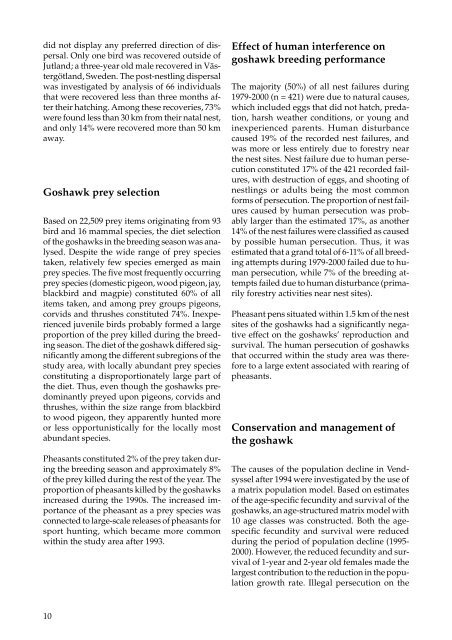Danske duehøges populations- økologi og forvaltning
Danske duehøges populations- økologi og forvaltning
Danske duehøges populations- økologi og forvaltning
Create successful ePaper yourself
Turn your PDF publications into a flip-book with our unique Google optimized e-Paper software.
did not display any preferred direction of dispersal.<br />
Only one bird was recovered outside of<br />
Jutland; a three-year old male recovered in Västergötland,<br />
Sweden. The post-nestling dispersal<br />
was investigated by analysis of 66 individuals<br />
that were recovered less than three months after<br />
their hatching. Among these recoveries, 73%<br />
were found less than 30 km from their natal nest,<br />
and only 14% were recovered more than 50 km<br />
away.<br />
Goshawk prey selection<br />
Based on 22,509 prey items originating from 93<br />
bird and 16 mammal species, the diet selection<br />
of the goshawks in the breeding season was analysed.<br />
Despite the wide range of prey species<br />
taken, relatively few species emerged as main<br />
prey species. The five most frequently occurring<br />
prey species (domestic pigeon, wood pigeon, jay,<br />
blackbird and magpie) constituted 60% of all<br />
items taken, and among prey groups pigeons,<br />
corvids and thrushes constituted 74%. Inexperienced<br />
juvenile birds probably formed a large<br />
proportion of the prey killed during the breeding<br />
season. The diet of the goshawk differed significantly<br />
among the different subregions of the<br />
study area, with locally abundant prey species<br />
constituting a disproportionately large part of<br />
the diet. Thus, even though the goshawks predominantly<br />
preyed upon pigeons, corvids and<br />
thrushes, within the size range from blackbird<br />
to wood pigeon, they apparently hunted more<br />
or less opportunistically for the locally most<br />
abundant species.<br />
Pheasants constituted 2% of the prey taken during<br />
the breeding season and approximately 8%<br />
of the prey killed during the rest of the year. The<br />
proportion of pheasants killed by the goshawks<br />
increased during the 1990s. The increased importance<br />
of the pheasant as a prey species was<br />
connected to large-scale releases of pheasants for<br />
sport hunting, which became more common<br />
within the study area after 1993.<br />
10<br />
Effect of human interference on<br />
goshawk breeding performance<br />
The majority (50%) of all nest failures during<br />
1979-2000 (n = 421) were due to natural causes,<br />
which included eggs that did not hatch, predation,<br />
harsh weather conditions, or young and<br />
inexperienced parents. Human disturbance<br />
caused 19% of the recorded nest failures, and<br />
was more or less entirely due to forestry near<br />
the nest sites. Nest failure due to human persecution<br />
constituted 17% of the 421 recorded failures,<br />
with destruction of eggs, and shooting of<br />
nestlings or adults being the most common<br />
forms of persecution. The proportion of nest failures<br />
caused by human persecution was probably<br />
larger than the estimated 17%, as another<br />
14% of the nest failures were classified as caused<br />
by possible human persecution. Thus, it was<br />
estimated that a grand total of 6-11% of all breeding<br />
attempts during 1979-2000 failed due to human<br />
persecution, while 7% of the breeding attempts<br />
failed due to human disturbance (primarily<br />
forestry activities near nest sites).<br />
Pheasant pens situated within 1.5 km of the nest<br />
sites of the goshawks had a significantly negative<br />
effect on the goshawks’ reproduction and<br />
survival. The human persecution of goshawks<br />
that occurred within the study area was therefore<br />
to a large extent associated with rearing of<br />
pheasants.<br />
Conservation and management of<br />
the goshawk<br />
The causes of the population decline in Vendsyssel<br />
after 1994 were investigated by the use of<br />
a matrix population model. Based on estimates<br />
of the age-specific fecundity and survival of the<br />
goshawks, an age-structured matrix model with<br />
10 age classes was constructed. Both the agespecific<br />
fecundity and survival were reduced<br />
during the period of population decline (1995-<br />
2000). However, the reduced fecundity and survival<br />
of 1-year and 2-year old females made the<br />
largest contribution to the reduction in the population<br />
growth rate. Illegal persecution on the

















